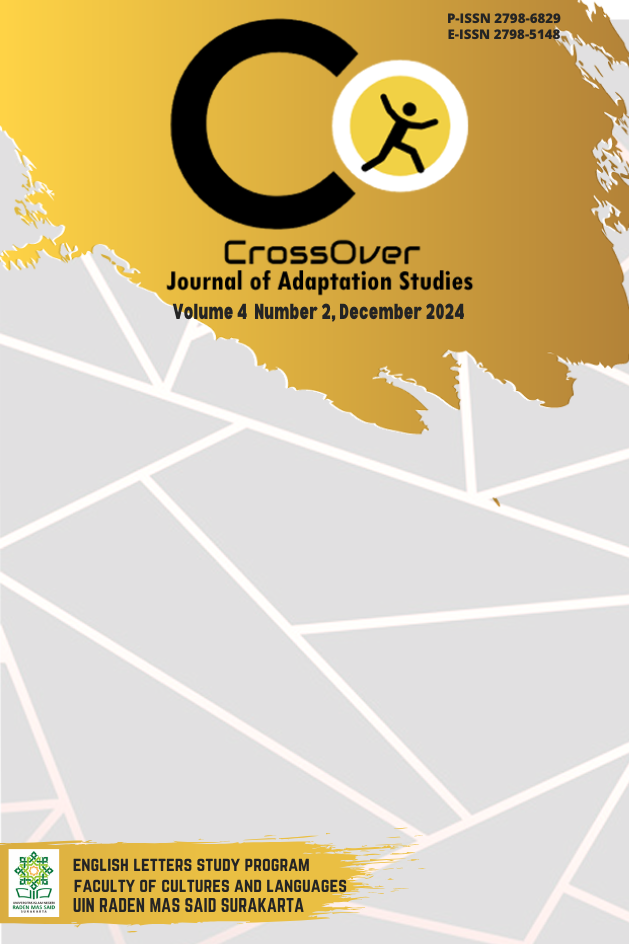Count Dracula, Louis De Pointe Du Lac and Edward Cullen: The Archetypal Shift of Vampires Figures Across Three Eras of English Literature
DOI:
https://doi.org/10.22515/crossover.v4i2.9933Keywords:
Vampire, Archetype, Archetypal Shift, CharacterizationAbstract
The research aims at finding out the archetype, archetypal shift and the dominant archetype of vampire figures: Count Dracula, Louis de Pointe du Lac and Edward Cullen. The methods used in this research is descriptive qualitative research, used documentation as the technique of collecting data. In this research, the researcher used Archetype theory by Margareth Mark and Carol Pearson and Linda Hutcheon’s theory of shifting to analyze the data. The result of this research showed that there were 137 data in total and are 10 of 12 total archetypes. The analysis on the archetypal shifting classified were; 8 archetypes uses historicizing and 129 dehistoricing. 15 archetyes uses racializing and 122 archetypes uses deracializing. 9 Disembodiments and 3 embodiments. It is found that each figure has a different orientation of characterization depicted its own zeitgeist. Count Dracula a vampire from Victorian era has a clear characterization of a ruler. Contrastingly, Louis de Pointe du Lac of post-modern era has an ambigous personality of being good ‘evil’ and is bond through his past. Differently, A vampire of Contemporary era, Edwrad Cullen, has an obvious characterization as a lover with 2 dominant archetypes takes 66% of the data. Furthermore, the dominant archetype of the data is the Lover which takes 30% of the data as both Louis and Edward created in the era where there is no distinguish point of being good and evil.
Keywords: Vampire, Archetype, Archetypal Shift, Characterization.
Downloads
References
Abrams, M. H. (2009). A glossary of literary terms (9th ed.). Wadsworth Cengage Learning.
Ahmada, F. A. (2016). Comparative analysis of archetypal characters of Shakespeare’s Romeo and Juliet and its film adaptation.
Amalia, F. (2014). Archetypal hero as reflected in Harry Potter’s character in J.K. Rowling’s Harry Potter heptalogy.
Arikunto, S. (2006). Prosedur penelitian: Suatu pendekatan praktik. Rineka Cipta.
Ary, D., Jacobs, L., Sorensen, C., & Walker, D. (2009). Introduction to research in education (8th ed.). Wadsworth Cengage Learning.
Bennett, A., & Royle, N. (2014). An introduction to literature, criticism and theory (4th ed.). Routledge.
Binulia, Y. A. (2015). Vampire’s heroic images in Stephanie Meyer’s Twilight: An archetypal criticism.
Creswell, J. W. (2007). Qualitative inquiry and research design: Choosing among five approaches (2nd ed.). Sage.
Definition of archetype. (2019). In Merriam-Webster. Retrieved January 14, 2019, from https://www.merriam-webster.com/dictionary/archetype
Eldridge, A. (2019). Vampire: Characteristics, history, folklore, & facts. In Britannica. Retrieved February 10, 2019, from https://www.britannica.com/topic/vampire
Forster, E. M. (1927). Aspects of the novel. Harcourt, Brace.
Frye, N., & Bloom, H. (2000). Anatomy of criticism. Princeton University Press.
Graves, R. (1990). The Greek myths: Volume 1. Penguin Books.
Glosbe. (2019). Dehistoricize - definition - English. Retrieved November 8, 2019, from https://glosbe.com/en/en/dehistoricize
Hurwitz, S. (2009). Lilith, the first Eve: Historical and psychological aspects of the dark feminine (3rd ed.). Daimon Verlag.
Hutcheon, L. (2006). A theory of adaptation. Routledge.
Jung, C. G. (1961). Modern man in search of a soul. Routledge & Kegan Paul.
Jung, C. G., & Hull, R. F. C. (1959). The archetypes and the collective unconscious (Vol. 9, Part 1). Pantheon Books.
Kennedy, X. J., & Gioia, D. (2007). Literature: An introduction to fiction, poetry, drama, and writing (5th ed.). Pearson Longman.
Korstanje, M. (2015). Dracula and the rights of hospitality: The axis of evil. Corvinus Journal of Sociology and Social Policy, 6(1), 113–127. https://doi.org/10.14267/cjssp.2015.01.06
Kristjánsdóttir, E. (2014). The vampire in literature: Old and new. Retrieved August 14, 2018, from http://hdl.handle.net/1946/17164
Leedy, P. D., Ormrod, J. E., & Johnson, L. R. (1980). Practical research: Planning and design. Macmillan.
Mark, M., & Pearson, C. S. (2001). The hero and the outlaw: Harnessing the power of archetypes to create a winning brand. McGraw-Hill.
Melton, J. G. (2011). The vampire book: The encyclopedia of the undead (4th ed.). Visible Ink Press.
Merriam, S. B. (2009). Qualitative research: A guide to design and implementation. Jossey-Bass.
Meyer, S. (2006). Twilight (Vol. 1). Little, Brown.
Moleong, L. J. (2016). Metode penelitian kualitatif. Rosda Karya.
Neumann, E. (1963). The great mother: An analysis of the archetype. Princeton University Press.
Oxford University Press. (n.d.). Archetype. In Oxford Advanced Learner's Dictionary. Retrieved October 1, 2024, from https://www.oxfordlearnersdictionaries.com
Parahoo, K. (2014). Nursing research: Principles, process and issues (3rd ed.). Palgrave Macmillan.
Rice, A. (2012). Interview with the vampire. Sphere.
Simpson, J., & Roud, S. (2003). A dictionary of English folklore. Oxford University Press.
Stoker, B. (2006). Dracula. Penguin Books.
Sutopo, H. D. (2002). Metodologi penelitian kualitatif: Dasar teori dan terapan dalam penelitian. Sebelas Maret University Press.
Downloads
Published
How to Cite
Issue
Section
Citation Check
License
Copyright (c) 2024 Bety Setiyawati

This work is licensed under a Creative Commons Attribution-ShareAlike 4.0 International License.
Authors retain copyright and grant the journal right of first publication with the work simultaneously licensed under a Creative Commons Attribution 4.0 International License that allows others to share the work with an acknowledgment of the work's authorship and initial publication in this journal.

















